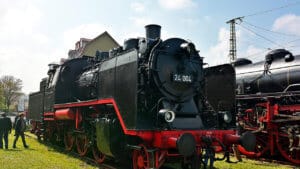The steam locomotive DRG Class 24 is a unit passenger locomotive of the Deutsche Reichsbahn. The typing program of the newly founded Deutsche Reichsbahn included mainly main railway locomotives. From 1925 was worked on Nebenbahnlokomotiven, with a large interchangeability of parts was planned. The first steam locomotives DRG Class 24 were built by the companies Schichau and Linke-Hofmann, the later 95 units also by other locomotive manufacturers between 1928 and 1940.
Details of DRG class 24
| Manufacturer: | Borsig, Hanomag, Henschel, Krupp, Linke-Hofmann, Schichau |
| Length: | 16955 mm |
| Numbering: | DR: 24 001-95 PKP: Oi 2 DR: 37.1 |
| Weight: | 57.4 t |
| Years of construction: | 1928 - 1940 |
| Top speed: | 90 km/h, 50 km/h (tender ahead) |
| Retirement: | 1972 |
| Fuel supply: | 6 t hard coal |
| Water supply: | 16.0 m³ |
| Number: | 95 |
| Power: | 677 kWi |
| Brake: | automatically acting single chamber compressed air brake type Knorr, acting on dome- and running wheels from front |
| Boiler overpressure: | 14 bar |
| Interesting facts |
|---|
| The DRG class 24 steam locomotive is of the 1'C h2 type and contains three coupled sets of driving wheels in the main frame with a movable running axle bogie at the front. The steam type is superheated steam and it has 2 cylinders. More interesting facts |
DRG Class 24 - standard version and different versions

The locomotives with the operating numbers 24 069 and 24 070 were delivered by the company Borsig as test locomotives with a medium pressure boiler (25 bar boiler pressure). The boiler, as well as the firebox were made of molybdenum steel. The 24 069 was designed as a two-cylinder compound locomotive. The right high-pressure cylinder received 400 mm and the left, as a low-pressure cylinder, 600 mm diameter. The piston stroke corresponded to 660 mm standard version. The locomotive 24 069 had in this version the lowest steam consumption (4.9 kg / PSih) of all German piston steam locomotives. Coal consumption (0.96 kg / PSh) was also extraordinarily low.
Locomotive 24 070 received only a simple steam expansion with DC steam engine after a design of Richard Paul Wagner. In this design, the steam flows in the same direction through the cylinder and exits in the middle of the cylinder again. The cylinders had a diameter of 380 mm and a Regelkolbenhub of 660 mm. The steam consumption, which is around 10% higher than the standard version, led to the machine being converted into a two-cylinder compound engine like in 24 069 in 1935. Even before the Second World War, boiler pressure was reduced to 20 bar due to boiler damage. In 1944 they were turned off. In 1952, both test machines were rebuilt in the repair shop Lingen in standard execution. Steam locomotive 24 061 received in 1948 a tender of the type 2’2’T26, which could save twice as much water and by a cab rear wall also reversing allowed a maximum speed of 80 km / h. In 1949, the Bissel axis was replaced by a krauss-Helmholtz steering column. In 1955 the machine returned to normal service.
Use and whereabouts of the DRG Class 24
Until 1945, the vehicles were used in 11 Reichsbahn directorates at the German Reichsbahn. The first 5 steam locomotives were located in the Bw Wriezen of Rbd Szczecin.
Since 1945, the 24 002, 004, 009 and 021 have remained with the Deutsche Reichsbahn. The machines were in the Rbd Greifswald and were delivered in 1947 to the Rbd Berlin. In 1956, the four steam locomotives came to Rbd Magdeburg, which stationed the locomotives in Bw Oschersleben and from 1957 in Bw Jerichow. The vehicles found their field of activity until 1968 on the route network of the Kleinbahn AG Genthin. Only 24 009 remained in use longer in 1970 came to Bw Stendal. In the Bw Stendal the locomotive received the company number 37 1009-2. The last station of the locomotive was the Bw Güsten, before the locomotive was sold in 1972 to the railway courier in the FRG. The German Federal Railroad had 47 locomotives, which were retired between 1960 and 1966. The last copy, the 24 067, which was based in Rheydt was decommissioned in August 1966.
A total of four steam locomotives of the class 24 have been preserved in museums, three of them in Germany (24 004, 24 009 and 24 083).
